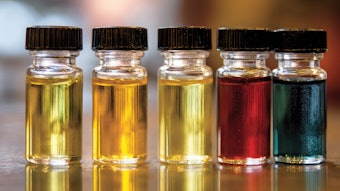3-Cyclohexyl-1-propanol and 3-cyclohexyl-1-butanol rank among synthetic fragrant compounds. The fragrant properties of 3-cyclohexyl-1-propanol have been reported in the literature as very mild, sweet balsamic, but rather “flat” odor of moderate to poor tenacity. It is less floral than hydrocinnamic alcohol, and does not have the rosy character of that material. The properties of 3-cyclohexyl-1-butanol have been described in our preceding paper: woody odor of santal type, floral odor,
Both alcohols are obtained by the hydrogenation of the respective phenyl substituted 1-alkanols. The starting raw material for their preparation is styrene or α-methyl-styrene, which via the Prins reaction with formaldehyde yields substituted 1,3-dioxans. These, in turn, may be split hydrogenolytically into phenyl substituted 1-alkanols. The preparation of 3-cyclohexyl- 1-propanol may be expressed by the accompanying equations.
3-Cyclohexyl-1-butanol was prepared in a similar way from α-methylstyrene.










